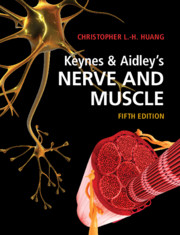Book contents
- Keynes & Aidley’s Nerve and Muscle
- Keynes & Aidley’s Nerve and Muscle
- Copyright page
- Dedication
- Contents
- Preface
- Acknowledgements
- Abbreviations used in the text
- 1 Structural Organisation of the Nervous System
- 2 Resting and Action Potentials
- 3 Background Ionic Homeostasis of Excitable Cells
- 4 Membrane Permeability Changes During Excitation
- 5 Voltage-Gated Ion Channels
- 6 Cable Theory and Saltatory Conduction
- 7 Neuromuscular Transmission
- 8 Synaptic Transmission in the Nervous System
- 9 The Mechanism of Contraction in Skeletal Muscle
- 10 The Activation of Skeletal Muscle
- 11 Excitation–Contraction Coupling in Skeletal Muscle
- 12 Contractile Function in Skeletal Muscle
- 13 Cardiac Muscle
- 14 Ion Channel Function and Cardiac Arrhythmogenesis
- 15 Smooth Muscle
- Further Reading
- References
- Index
14 - Ion Channel Function and Cardiac Arrhythmogenesis
Published online by Cambridge University Press: 07 November 2020
- Keynes & Aidley’s Nerve and Muscle
- Keynes & Aidley’s Nerve and Muscle
- Copyright page
- Dedication
- Contents
- Preface
- Acknowledgements
- Abbreviations used in the text
- 1 Structural Organisation of the Nervous System
- 2 Resting and Action Potentials
- 3 Background Ionic Homeostasis of Excitable Cells
- 4 Membrane Permeability Changes During Excitation
- 5 Voltage-Gated Ion Channels
- 6 Cable Theory and Saltatory Conduction
- 7 Neuromuscular Transmission
- 8 Synaptic Transmission in the Nervous System
- 9 The Mechanism of Contraction in Skeletal Muscle
- 10 The Activation of Skeletal Muscle
- 11 Excitation–Contraction Coupling in Skeletal Muscle
- 12 Contractile Function in Skeletal Muscle
- 13 Cardiac Muscle
- 14 Ion Channel Function and Cardiac Arrhythmogenesis
- 15 Smooth Muscle
- Further Reading
- References
- Index
Summary
Arrhythmias, frequently diagnosed through their characteristic electrocardiographic abnormalities, pose major public health problems contributing significant clinical morbidity and mortality. They result from breakdown of the normally orderly sequence of electrical activation through the heart. Although initiated by triggering events, they are sustained by the presence of re-entrant substrate arising from compromised, or heterogeneities in, action-potential conduction and/or recovery. These situations can arise from abnormal surface ion channel, Ca2+ homeostatic, cardiomyocyte metabolic function and/or cardiac remodelling or anatomical abnormalities. They proved amenable to study in genetically modified murine systems recapitulating clinically demonstrated abnormalities in their underlying biomolecules. These mirrored the features and mechanisms underlying human pro-arrhythmic conditions, including sinus node disorder, atrial arrhythmias, the Brugada and long QT syndromes, catecholaminergic polymorphic ventricular tachycardia, energetic and ion homeostatic disorders, and longer-term fibrotic or hypertrophic change. This led to recent classifications of arrhythmic mechanisms in different clinical situations, potentially modernising their management.
Keywords
- Type
- Chapter
- Information
- Keynes & Aidley's Nerve and Muscle , pp. 225 - 251Publisher: Cambridge University PressPrint publication year: 2020



